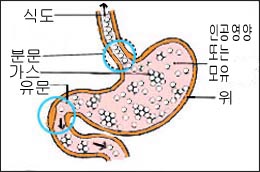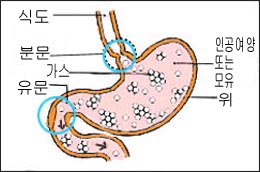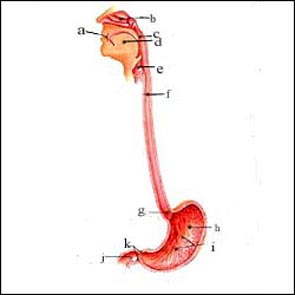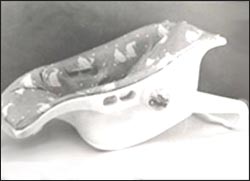먹은 모유나 인공영양을 위식도 역류로 인해 넘길 때, Spitting up breast milk or infant formula by gastroesophageal reflex

그림 105. 신생아들이나 영아들의 분문의 괄약근육은 정상적으로 미약해 분문이 쉽게 열릴 수 있고 그로 인해 먹은 젖이나 인공영양 등이 위 속에서 식도관 속으로 생리적으로 역류돼 인두 강, 입안으로 넘길 수 있다. 이런 현상을 생리적 위 식도 역류라고 한다. 이런 현상은 정상이다.
Copyright ⓒ 2011 John Sangwon Lee, MD., FAAP

그림 106. 모유나 인공영양을 먹은 후 분문이 꼭 닫히면 먹었던 인공영양이나 모유 등 위 속 음식물이 위 식도 역류로 인두 강 또는 입안으로 넘어오지 않는 것이 정상이다.
Copyright ⓒ 2011 John Sangwon Lee, MD., FAAP
- 신생아들이나 영아들이 아무 병이 없는데도 먹은 위 속 젖이나 인공영양을 열린 분문을 통해 식도관 속으로 역류되어 인두 강 또는 입 안으로 넘길 수 있다. 이런 현상을 생리적 일류(Physiologic vomiting), 또는 생리적 위식도 역류(Physiologic gastroesophageal reflex)라고 한다.
- 생리적 위식도 역류는 1세 되기 전 자연히 없어지는 것이 보통이다(p.00 위식도 역류와 위식도 역류병을 참조). 위 속에 있는 먹은 모유나 인공영양을 생리적으로 넘길 때는 일류, 또는 일유(溢乳)라고도 한다.
- 때로는, 식도나 위에 생긴 어떤 이상, 특히, 분문 이상으로 먹었던 위 내 음식물이 분문을 통해 식도 속으로 역류될 수 있다.
- 이런 비정상적인 역류 현상을 병적 위식도 역류(Pathological gastroesophageal reflex)라고 한다. 이때는 먹은 위 내 모유나 인공영양이 더 많이 더 심하게 넘어 올라올 수 있다. 이것은 일종의 병적 일류, 또는 병적 위식도 역류이다.
- 경미한 병적 일류의 증상 징후와 생리적 일류의 증상 징후가 거의 같을 수 있다.
- 대부분 병적 일류도 자연히 낫기 때문에 이 두 종류의 일류를 확실히 분별하기가 곤란한 때도 있다.
- 모유, 인공영양 등을 먹은 후 위장염 등으로 토해 내는 것은 일류라 하지 않고 구토라고 한다.
모유나 인공영양을 위식도 역류로 넘기는 원인

그림 107. 입, 인두, 식도, 위, 분문, 유문
a-입, b-비강, c-인두, d-혀, e-후두, f-식도, g-분문, h-위, i-위벽, j-십이지장, k-유문
Used with permission from Galaxo Wellcome
- 식도(관)와 위 사이에 있는 부위를 분문이라고 한다. 분문은 괄약근으로 형성되고 그 괄약근으로 분문이 열리고 닫힌다.
- 먹은 젖이나 인공영양 또는 음식물이 전체 식도관 속을 통과한 다음 분문에 이를 때 분문이 자연적으로 열리고 식도관 속에 있는 음식물이 열린 분문을 통과한 후 위 속으로 들어가는 것이 정상적 생리이다.
- 음식물 등이 위 속으로 들어간 후 바로 분문은 자연적으로 닫힌다. 그리고 위 속에 들어간 음식물은 유문을 통과해서 십이지장(관) 속으로 들어가는 것이 정상적 생리이다.
- 영유아기, 그 이후 학령기나 사춘기 아이들이나 성인들이 삼킨 음식물은 식도관 속과 분문을 통과해서 위 속으로 들어간 후 분문→식도관 속으로 역류돼서 인두 강, 입안으로 정상적으로 넘어오지 않는 것이 보통이다.
- 그렇지만, 일반적으로 돌 이전 대부분의 영아들의 분문의 괄약근은 정상적으로 미약하기 때문에 분문이 쉽게 열릴 수 있다.
- 그래서 먹은 위 속 모유, 인공영양, 가스 또는 이유식 등이 위 식도 역류로 조금씩 때로는 많이 인두 강, 입안으로 넘어올 수 있다.
- 젖이나 인공영양을 먹은 건강한 신생아들이나 영아들을 업어주거나 좀 심하게 다루거나 제대로 트림을 시키지 않거나 손가락이나 노리개 젖꼭지를 입안 속 깊숙이 넣고 빨면 위 속 모유나 인공영양 또는 가스를 조금씩 넘길 수 있다. 이렇게 생리적으로 분문 괄약근이 이완되어 생긴 일류는 정상적이고 생리적 일류에 속한다.
- 인공영양에 든 우유 단백질이나 콩 단백질 등으로 생긴 알레르기 반응으로 젖이나 인공영양을 넘길 수 있다.
- 다시 설명하면, 분문 괄약근이 비정상적으로 이완되고 그로 인해 먹은 젖이나 인공영양을 쉽게 많이 자주 넘길 수 있다(그림105 참조). 이런 병을 분문 이완증(噴門弛緩症), 위식도 역류증(胃食道逆流症), 칼라시아, 병적 일류, 또 병적 위식도 역류라고 한다.
모유나 인공영양을 위식도 역류로 넘길 때의 진단과 치료
- 병력·증상 징후·진찰소견 등을 종합해서 이 위식도 역류를 진단할 수 있다.
- 식도관 최하부에 있는 분문 부분의 산성도(pH, 酸性度)를 측정해서 정상적인 생리적 위식도 일류와 비정상적인 위식도 역류를 감별 진단할 수 있다.그러나 임상적으로 많이 쓰는 검사는 아니다.
- 뇌 손상·정신박약·뇌성마비·횡격막 헤르니아 등으로 병적 위식도 일류가 생길 수 있다.
- 젖이나 인공영양을 많이 넘기면 생리적으로 생긴 생리적 위식도 일류와 병적 위식도 일류를 감별 진단해야 한다.
- 영유아가 젖을 심하게 넘기거나, 잘 성장발육하지 않으면 우유병 속에 넣은 액체 바륨 조영물을 먹이면서 식도·위·십이지장 X-선 검사를 해서 진단할 수 있다.
- 젖이나 인공영양을 넘기는 원인을 찾아내어 그 원인에 따라 치료한다.
- 우유 단백질이 들은 인공영양을 먹고 우유 단백 알레르기로 구토하거나 넘길 수 있다.
- 이때에는 콩 단백질이 들은 인공영양이나 특수 가수분해 단백 인공영양으로 치료하기도 한다.
- 병적 분문 이완증으로 모유나 인공영양을 심하게 넘길 때에는 모유, 인공영양, 또는 이유식을 먹인 바로 후 30∼60분 동안 영유아를 꼿꼿이 세워 안아주든지, 영유아 의자(infant chair)에 비스듬히 앉혀 육체적으로 정신적으로 편안하게 하면 덜 넘길 수 있다(사진 109 참조).
- 먹은 위 속 모유나 인공영양이 중력으로 위 속에서 십이지장관 속으로 더 쉽게 내려가도록 영아의 체위를 유지하면 위 속에서 식도관 속으로 덜 역류된다. 그러나 이 방법으로 치료해도 계속 넘기는 아기들도 있다.
- 이 경우에는 모유나 인공영양에 쌀 곡분 시리얼을 섞어 수저로 떠 먹여 치료해 볼 수 있다.
- 참고로 모유를 먹는 영아들의 대부분은 인공영양을 먹는 영아들보다 젖을 덜 넘긴다.
- 젖이나 인공영양을 자주 넘기면 먹인 후 바로 업어 주거나 너무 많이 추스르지 말아야 한다.
- 젖이나 인공영양을 먹일 때 트림을 잘 시키고 한 번에 너무 많이 먹이지도 말고 또 너무 자주 먹이지 말아야 한다. 심한 병적 분문 이완증(병적 위식도 역류증)이나 횡격막 헤르니아 등으로 젖이나 인공영양을 심하게 넘기거나 구토해서 성장이 지연될 때는 수술로 치료할 수도 있다.
- Bethanechol이나 Cisapride 등의 약물로 심한 병적 위식도 역류를 치료하기도 한다.

그림 108. 왼쪽 그림-인공영양이나 모유를 먹인 후 영아를 세워 앉히면 영아가 덜 넘긴다.
우측 그림-인공영양이나 모유를 먹인 후 영아를 바로 뉘면 영아가 더 넘길 수 있다.
Copyright ⓒ 2011 John Sangwon Lee, MD., FAAP

사진 109. 병적 위식도 역류로 자주 넘기면 젖이나 인공영양을 먹인 후 영아를 영아 의자(infant chair)(위 사진)에 잠시 동안 앉히면 덜 넘길 수 있다. 그러나 이 치료 효과에 관해 찬반이 최근 있다.
Copyright ⓒ 2011 John Sangwon Lee, MD, FAAP
|
다음은 “위식도 역류, 구토, 우유 알레르기로 우유를 자꾸 역류해요.”에 관한 인터넷 소아청소년 건강상담 질의응답의 예 입니다. |
Q&A.위식도 역류, 구토, 우유 알레르기로 우유를 자꾸 역류해요.
Q.
생후 22일된 남자 아기입니다.
몸무게는 4.4kg이구요.
애기가 우유를 먹고 트림을 시키거나 트림을 하지 않으면 5~10분쯤 안고 있다가 눕히면 우유를 조금 토해 내거나 입으로 흘러나옵니다.
그리고 종종 코로도 나오는 경우가 있습니다.
며칠 전 아기가 코가 막혀 가까운 소아청소년과 에 들렀다고 코로 우유가 나온다고 했더니 구강 구조에는 이상이 없다고 하셨어요.
어른들 말씀으로는 나올 때 양수를 먹은 애들이 그렇다고 하던데 사실인가요??
그리고 애기가 감기는 아닌 것 같은데 (열은 없음) 코가 막힙니다.
특히 새벽에 조금 더 심한 것 같구요.
신생아라 약을 먹이기가 좀 망설여지는데 좋은 방법이 없을까요?
A.
성이님
안녕하세요. 질문해 주셔서 감사합니다. 좋은 질문입니다.
자녀의 나이, 성별, 과거 병력, 가족 병력, 진찰소견, 임상검사 등의 정보를 많이 알수록 답변을 드리는데 도움이 됩니다. 주신 정보를 토대로 해서 답변을 드리겠습니다.
우유라고 하셨는데 우유는 조제분유를 말씀하시는 것이겠지요.
아기가 토하는 것과 젖을 넘기는 것은 다른 증상 징후이고 다른 원인으로 생길 수 있습니다.
토하는 것은 위장 어느 부분이 막히거나 위장염이 있거나 또는 뇌 등 신체의 어떤 계통의 어떤 기관에 이상이 있거나 그 외 다른 이유로 먹은 위 내용물이 입 밖으로 힘세게 나오는 증상입니다.
그러나 먹은 음식물이 힘없이 인두 강이나 입안이나 비강 속으로 나오는 것을 일류라고 합니다.
사실은 임상적으로 이렇게 구분 할 수 하지만 이 두 가지의 증상을 확실히 구별하기가 때로는 어렵습니다.
과식을 하거나 너무 자주 먹거나 분유가 체질에 맞지 않거나 위 식도 역류가 있을 때 젖을 넘기거나 토하는 경우가 가장 흔합니다. 원인에 따라 물론 치료를 해야 합니다.
코가 자주 막히는 것은 역시 알레르기 비염이 생기든지 혈관 운동성 비염 등으로 생길 수 있습니다.
젖을 넘기는 것과 코가 자주 막히는 증상, 이 둘의 증상을 종합해 보면 혹시 분유 속에 든 우유 단백이 아기의 체질에 맞지 않나 의심해 봅니다.
그러나 이렇게 어린 신생아에게 코 알레르기(알레르기 비염), 식품 알레르기는 생기지 않는다고 믿는 의사들도 있습니다. 그러나 가능합니다.
아직까지 자주 토하면 소아청소년과에서 진단받으시고 이런 문제에 관해서 상담하시기 바랍니다.
[부모도 반의사가 되어야 한다–소아가정간호 백과]-제5권 인공영양, 우유, 이유식, 비타민, 미네랄, 단백질, 탄수화물, 지방–우유, 비타민, 미네랄 참조.
일류,구토, 위식도 역류와 위식도 역류병. 제 15권 소아청소년 알레르기 및 자가 면역질환–알레르기 비염, 우유 알레르기 등을 참조하시기 바랍니다.
질문이 더 있으면 다시 연락해 주시기 바랍니다. 감사합니다. 이상원 드림
Spitting up breast milk or infant formula by gastroesophageal reflex

Figure 105. The sphincter muscles of the heart in newborns and infants are normally weak, so the heart can be opened easily. As a result, milk or artificial nutrition can be physiologically refluxed from the stomach into the esophagus and passed into the pharyngeal cavity and mouth. This phenomenon is called physiological gastroesophageal reflux. This phenomenon is normal. Copyright ⓒ 2011 John Sangwon Lee, MD., FAAP

Figure 106. When the heart is closed after taking breast milk or artificial nutrition, it is normal that food in the stomach, such as artificial nutrition or breast milk, does not flow into the pharynx or mouth due to gastroesophageal reflux. Copyright ⓒ 2011 John Sangwon Lee, MD., FAAP
• Newborns and infants, even when they are not ill, can regurgitate gastric milk or artificial nutrition through the open heart into the esophagus and pass it into the pharyngeal cavity or mouth. This phenomenon is called physiological vomiting or physiological gastroesophageal reflex.
• Physiological gastroesophageal reflux usually resolves spontaneously before 1 year of age (see Gastroesophageal Reflux and Gastroesophageal Reflux Disease). It is also called first-class or first-class milk or artificial nutrition when physiologically passed on to breast milk or artificial nutrition in the stomach.
• Occasionally, some abnormality in the esophagus or stomach, particularly food in the stomach that was eaten over the cardiac abnormality, can be refluxed through the cardiac gland into the esophagus.
• This abnormal reflux phenomenon is called pathological gastroesophageal reflex. At this time, breast milk or artificial nutrition in the stomach that has been eaten may go up more and more severely. This is a type of pathological first flow, or pathological gastroesophageal reflux.
• Signs of mild pathologic and physiological first-class symptoms may be nearly identical.
• In most cases, it is difficult to distinguish clearly between these two types of first-class because most pathological first-class also heals naturally.
• Vomiting due to gastroenteritis after eating breast milk or artificial nutrition is called vomiting, not first-class.
Causes of passing breast milk or artificial nutrition into gastroesophageal reflux

Figure 107. Mouth, pharynx, esophagus, stomach, heart, and pylorus a – mouth, b – nasal cavity, c – pharynx, d – tongue, e – larynx, f – esophagus, g – cardia, h – stomach, i – wall of stomach, j – duodenum, k – pylorus Used with permission from Galaxo Wellcome
• The area between the esophagus (tube) and the stomach is called the heart. The heart is formed by a sphincter, which opens and closes the heart.
• When breast milk, artificial nutrition, or food passes through the entire esophageal duct and then reaches the heart, it is normal physiology for the heart to open naturally and for food in the esophageal tube to pass through the open heart and enter the stomach.
• After food, etc. enters the stomach, the heart muscle closes naturally. And it is normal physiology for food that enters the stomach to pass through the pylorus and enter the duodenum (tube)
. • It is common for food swallowed by infants and children, school-age, adolescent children, and adults to pass through the esophageal tract and heart, into the stomach, and then flow back into the heart → esophagus tube and do not normally pass into the pharyngeal cavity and mouth.
• However, in most pre-natal infants, the cardiac sphincter is normally weak, so the heart can open easily.
• Therefore, breast milk, artificial nutrition, gas, or baby food from the stomach may flow into the pharynx or mouth little by little due to gastroesophageal reflux.
• Caring, handling, improper burping, or inserting a finger or soother into the mouth and sucking on healthy newborns or infants fed with milk or artificial nutrition can cause small amounts of milk, artificial nutrition, or gas from the stomach. The first class, which is physiologically caused by the relaxation of the cardiac sphincter, is normal and belongs to the physiological class.
• An allergic reaction caused by milk protein or soy protein contained in artificial nutrition can pass over milk or artificial nutrition.
• In other words, the cardiac sphincter is abnormally relaxed, which makes it easy to pass up milk or artificial nutrition very often (see Figure 105). These diseases are called cardiomyopathy (噴門弛緩症), gastroesophageal reflux disease (胃食道逆流症), calasia, pathological first class, and pathological gastroesophageal reflux disease.
Diagnosis and treatment when breast milk or artificial nutrition is passed into gastroesophageal reflux
• Gastroesophageal reflux can be diagnosed by combining medical history, symptoms, and examination findings.
• By measuring the acidity (pH, 酸性度) of the cardiac part at the bottom of the esophageal duct, it is possible to differentiate between normal physiological gastroesophageal reflux and abnormal gastroesophageal reflux. However, it is not a clinically widely used test.
• Brain damage, mental retardation, cerebral palsy, diaphragmatic hernia, etc. can cause pathological gastroesophageal first class.
• If a large amount of milk or artificial nutrition is exceeded, a physiological first gastroesophageal disorder and pathological gastroesophageal first class should be differentially diagnosed.
• If infants and toddlers are excessively breastfeeding or do not develop well, it can be diagnosed by performing X-ray examination of the esophagus, stomach, and duodenum while feeding the liquid barium contrast placed in a milk bottle.
• Find out the cause of passing milk or artificial nutrition and treat it according to the cause. • Consuming artificial nutrition with milk protein and may vomit or pass it on due to milk protein allergy.
• In this case, artificial nutrition containing soy protein or special hydrolyzed protein artificial nutrition is sometimes used.
• When breast milk or artificial nutrition is excessively passed due to pathologic cardiomyopathy, hold the infant upright for 30 to 60 minutes immediately after breastfeeding, artificial nutrition, or baby food is fed, or sit in an infant chair at an angle to physically and mentally If you’re comfortable, you can pass less (see photo 109).
• Maintaining the infant’s position so that ingested gastric milk or artificial nutrition is more easily gravity-fed down from the stomach into the duodenum, less reflux from the stomach into the esophagus. However, some babies continue to pass even after treatment with this method.
• In this case, you can try to treat it by mixing rice flour cereal with breast milk or artificial nutrition and feeding it with a spoon.
• For reference, most breastfed infants pass less milk than infants fed artificial nutrition.
• If you frequently pass milk or artificial nutrition, do not lift it up immediately after feeding it or do not overcook it.
• When feeding with breast milk or artificial nutrition, burp well, and don’t feed too much at once and don’t feed too often. When growth is delayed due to severe pathologic cardiomyopathy (pathologic gastroesophageal reflux disease) or diaphragmatic hernia, or excessive loss of milk or artificial nutrition or vomiting, it can be treated with surgery.
• Severe pathological gastroesophageal reflux is sometimes treated with drugs such as Bethanechol or Cisapride.

Figure 108. Left figure- If an infant sits upright after being fed artificial nutrition or breast milk, the infant will turn over less. Picture on the right – If you lay an infant right after feeding with artificial nutrition or breast milk, more infants can turn it over. Copyright ⓒ 2011 John Sangwon Lee, MD., FAAP

Picture 109. If you frequently pass due to pathological gastroesophageal reflux, it can be reduced by sitting the infant in an infant chair (pictured above) for a while after feeding with milk or artificial nutrition. However, there are recent arguments for and against this therapeutic effect. Copyright ⓒ 2011 John Sangwon Lee, MD, FAAP
The following is an example of Internet pediatric health counseling Q&A regarding “I keep refluxing milk due to gastroesophageal reflux, vomiting, and milk allergy.”
Q&A. I keep refluxing milk due to gastroesophageal reflux, vomiting, and milk allergy.
Q. This is a 22 day old baby boy. He weighs 4.4 kg. If the baby eats milk and does not burp or burp, hold it for 5 to 10 minutes and then lay it down to spit out a little milk or it will come out of the mouth. And it often comes out through the nose.
A few days ago, the baby had a stuffy nose and went to the nearest pediatrician. When he said that milk was coming out of his nose, he said there was nothing wrong with the structure of his mouth. Adults say that children who drank amniotic fluid when they came out are the same, is it true? And the baby doesn’t seem to have a cold (no fever), but his nose is stuffy. It seems to be a little worse, especially in the morning. I’m a little hesitant to take medicine because I’m a newborn, so isn’t there a better way?
A. surname Good morning. Thanks for asking. That’s a good question. The more information you know about your child’s age, gender, past medical history, family history, examination findings, and clinical tests, the more helpful it is to give you an answer. We will give you an answer based on the information you provided. You said milk, but milk means formula milk. Babies vomiting and lactation are different signs and can have different causes. Vomiting is a symptom of strong stomach contents coming out of the mouth due to blockage in any part of the stomach, gastroenteritis, or any organ in the body, such as the brain, or for other reasons. However, it is called first-class when the food you eat comes out of the pharynx or into the mouth or nasal passages without force. In fact, it is clinically possible to distinguish this way, but it is sometimes difficult to clearly distinguish between the two symptoms. Lactation or vomiting is most common when you overeat, eat too often, don’t fit your formula, or have gastroesophageal reflux. Depending on the cause, of course, treatment is required.
Frequent nasal congestion can also be caused by allergic rhinitis or vasomotor rhinitis. If you look at the symptoms of both breastfeeding and frequent nasal congestion, I suspect that the milk protein in the formula is not suitable for the baby’s constitution. However, some doctors believe that these young newborns do not develop nasal allergies (allergic rhinitis) or food allergies.
But it is possible. If you still vomit frequently, get a diagnosis from the Department of Pediatrics and consult about these problems.www.drleepediatrics.com- See Volume 5 Artificial Nutrition, Milk, Baby Food, Vitamins, Minerals, Protein, Carbohydrates, Fat-Milk, Vitamins and Minerals. Flow, vomiting, gastroesophageal reflux and gastroesophageal reflux disease. Please refer to Volume 15 Children and Adolescent Allergy and Autoimmune Diseases-Allergic Rhinitis, Milk Allergy, etc. If you have any more questions, please contact us again. Thank you. Lee Sang-won Dream
출처 및 참조 문헌 Sources and references
- NelsonTextbook of Pediatrics 22ND Ed
- The Harriet Lane Handbook 22ND Ed
- Growth and development of the children
- Red Book 32nd Ed 2021-2024
- Neonatal Resuscitation, American Academy Pediatrics
- www.drleepediatrics.com 제1권 소아청소년 응급 의료
- www.drleepediatrics.com 제2권 소아청소년 예방
- www.drleepediatrics.com 제3권 소아청소년 성장 발육 육아
- www.drleepediatrics.com 제4권 모유,모유수유, 이유
- www.drleepediatrics.com 제5권 인공영양, 우유, 이유식, 비타민, 미네랄, 단백질, 탄수화물, 지방
- www.drleepediatrics.com 제6권 신생아 성장 발육 육아 질병
- www.drleepediatrics.com제7권 소아청소년 감염병
- www.drleepediatrics.com제8권 소아청소년 호흡기 질환
- www.drleepediatrics.com제9권 소아청소년 소화기 질환
- www.drleepediatrics.com제10권. 소아청소년 신장 비뇨 생식기 질환
- www.drleepediatrics.com제11권. 소아청소년 심장 혈관계 질환
- www.drleepediatrics.com제12권. 소아청소년 신경 정신 질환, 행동 수면 문제
- www.drleepediatrics.com제13권. 소아청소년 혈액, 림프, 종양 질환
- www.drleepediatrics.com제14권. 소아청소년 내분비, 유전, 염색체, 대사, 희귀병
- www.drleepediatrics.com제15권. 소아청소년 알레르기, 자가 면역질환
- www.drleepediatrics.com제16권. 소아청소년 정형외과 질환
- www.drleepediatrics.com제17권. 소아청소년 피부 질환
- www.drleepediatrics.com제18권. 소아청소년 이비인후(귀 코 인두 후두) 질환
- www.drleepediatrics.com제19권. 소아청소년 안과 (눈)질환
- www.drleepediatrics.com 제20권 소아청소년 이 (치아)질환
- www.drleepediatrics.com 제21권 소아청소년 가정 학교 간호
- www.drleepediatrics.com 제22권 아들 딸 이렇게 사랑해 키우세요
- www.drleepediatrics.com 제23권 사춘기 아이들의 성장 발육 질병
- www.drleepediatrics.com 제24권 소아청소년 성교육
- www.drleepediatrics.com 제25권 임신, 분만, 출산, 신생아 돌보기
- Red book 29th-31st edition 2021
- Nelson Text Book of Pediatrics 19th- 21st Edition
- The Johns Hopkins Hospital, The Harriet Lane Handbook, 22nd edition
- 응급환자관리 정담미디어
- Pediatric Nutritional Handbook American Academy of Pediatrics
- 소아가정간호백과–부모도 반의사가 되어야 한다, 이상원 저
- The pregnancy Bible. By Joan stone, MD. Keith Eddleman, MD
- Neonatology Jeffrey J. Pomerance, C. Joan Richardson
- Preparation for Birth. Beverly Savage and Dianna Smith
- 임신에서 신생아 돌보기까지. 이상원
- Breastfeeding. by Ruth Lawrence and Robert Lawrence
- Sources and references on Growth, Development, Cares, and Diseases of Newborn Infants
- Emergency Medical Service for Children, By Ross Lab. May 1989. p.10
- Emergency care, Harvey Grant and Robert Murray
- Emergency Care Transportation of Sick and Injured American Academy of Orthopaedic Surgeons
- Emergency Pediatrics A Guide to Ambulatory Care, Roger M. Barkin, Peter Rosen
- Quick Reference To Pediatric Emergencies, Delmer J. Pascoe, M.D., Moses Grossman, M.D. with 26 contributors
- Neonatal resuscitation Ameican academy of pediatrics
- Pediatric Nutritional Handbook American Academy of Pediatrics
- Pediatric Resuscitation Pediatric Clinics of North America, Stephen M. Schexnayder, M.D.
-
Pediatric Critical Care, Pediatric Clinics of North America, James P. Orlowski, M.D.
-
Preparation for Birth. Beverly Savage and Dianna Smith
-
Infectious disease of children, Saul Krugman, Samuel L Katz, Ann A.
- 제4권 모유, 모유수유, 이유 참조문헌 및 출처
- 제5권 인공영양, 우유, 이유, 비타민, 단백질, 지방 탄수 화물 참조문헌 및 출처
- 제6권 신생아 성장발육 양호 질병 참조문헌 및 출처
- 소아과학 대한교과서
Copyright ⓒ 2014 John Sangwon Lee, MD., FAAP
“부모도 반의사가 되어야 한다”-내용은 여러분들의 의사로부터 얻은 정보와 진료를 대신할 수 없습니다.
“The information contained in this publication should not be used as a substitute for the medical care and advice of your doctor. There may be variations in treatment that your doctor may recommend based on individual facts and circumstances.
“Parental education is the best medicine.